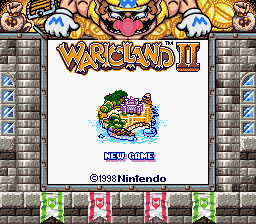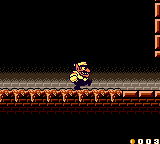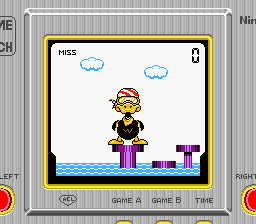Wario Land II
| Wario Land II |
|---|
|
Also known as: Wario Land 2: Nusumareta Zaihō (JP)
|
Wario Land II is the popular sequel to the popular Wario Land: Super Mario Land 3, in which Wario collects treasure while being squashed, set on fire, zombified, and all sorts of other fun stuff. It received a Game Boy Color port surprisingly quickly, with the Japanese release coming out just seven months after the Game Boy version's American release (note that the Game Boy version never came out in Japan), though the transition to color was... varying in quality.
Interestingly, despite its name, Wario Land II is actually the third game in the series; the second was Virtual Boy Wario Land, but given that game came out on the Virtual Boy, Nintendo doesn't really acknowledge it.
Contents
Sub-Pages
| Prerelease Info |
| Notes |
Unused Graphics
Mini-Game
These are larger versions of the coin and button graphics used in the Matching Game.
Go to the cellar!!
These two graphics are similar to the graphics used in the levels from the chapter "Go to the cellar!!". The difference is that these graphics have less detail than the ones used. It is possible that these were intended for areas in the levels that had dimmer lighting.
Extra Tileset
This tileset appears to be completed, but it is never used in-game. Unlike every other tileset used in the game, the numbers 1-4 are not in the top-left portion of this tileset.
Giant Snake
These graphics look like they were intended to be used with the giant snake boss.
Fire
These graphics were probably meant to be used as another way of catching Wario on fire.
Ending
This copyright graphic is part of the font set used in the game's endings. This was created before the game was delayed to 1998.
Unused Enemies
Worm
In the object set that contains the bee enemy, there is an unused graphic of a worm. The tile set that uses the bee enemy also contains an unused tile of a hole. The worm and the hole may be possibly linked.
Unused Objects
Jugs
One of the unused objects in the object set as the room with the floating jug is a jug without the ability to spin. Another object in that set is a jug spawner. It is similar to the cabinet spawner found in "Turn off the giant faucet".
Like the cabinets, the jugs react to water current, although this is never seen in-game.
Sticky Block
Levels that use the same tileset as "Go down to the cellar" contain an unused tile. This tile causes Wario to slow down when standing on it, limiting his speed and jumping height. He also cannot dash or duck when on this block. Similar to the conveyor belt in the factory levels, holding an enemy while on it causes it to act like a normal block. Part of this object can be seen on the floor of a pre-release screenshot.
Inaccessible Areas
Coins
In the level "Hold on to the owl", there are four 10 Gold Coins that cannot be reached. Most likely, the developers forgot to change the wall from solid to breakable.
Connection with Game Boy Gallery
| To do: See whether or not the paletted borders were carried over and still exist. Palettes are set by the PCT_TRN command. |
The unlockable minigame Flagman D-D, as the name implies, is a remake of the Game & Watch game Flagman. Interestingly, this version wasn't created from scratch, but is instead based on the version of Flagman included in the extremely obscure Game Boy Gallery, specifically its Game B mode. The flagman himself and the pig and frog accompanying him were replaced with Dangerous Duck and the enemies Pu and Gugi respectively, but nearly all other graphics are identical to those from Game Boy Gallery, albeit with different palettes, the "Game A/B" indicator missing (since only Game B is present) and D.D.'s platform missing its shadow for some reason (though the latter was fixed in the Game Boy Color version, which also gave the clouds and water a bit more detail). It even retains Game Boy Gallery's pause menu and Super Game Boy border!
There is one difference between the two gameplay-wise, however. In Flagman D-D, the B and A buttons come into play at 10 and 15 points respectively, whereas Flagman Game B in Game Boy Gallery introduces them 5 points earlier at 5 and 10 points.
Connection with Game Boy Color Promotional Demo
Fonts, music, and all sound effects from Wario Land II are present in the Game Boy Color Promotional Demo. Nintendo likely built the tech demo using Wario Land II, probably because they wanted to save some time and quickly borrow the graphics and sound effects necessary for recreating the cutscenes.
Regional Differences
Title Screen
The later Japanese version, which first added Game Boy Color support to coincide with its release, has additional differences.
| International (SGB) | Japan (SGB) |
|---|---|
 |
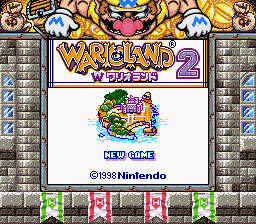 |
| International (GBC) | Japan (GBC) |
|---|---|
 |
 |
The International version differs slightly from the original release (seen above) in that the copyright, island and number are moved slightly upwards, and a border surrounds the logo. The Japanese release retains these details, but the roman numeral II was shifted down and changed to the standard arabic numeral 2 with a different texture, Wario's eye was also added to the O rather than it being merely filled in, and the "Wario Land" logo has its katakana equivalent (ワリオランド) and a "W" emblem underneath it (all of which can also be seen in a pre-release screenshot that predates the international release).
Compared to the original release, the image was touched up slightly when played on a Super Game Boy, although a few pixels in the water are mistakenly given the wrong color. On the Game Boy Color, among other general changes, the International version also corrected the numeral's color to red to reflect the box art (even though the palette change also affects the castle). In addition, the ™ symbol in the International release was changed to a ® symbol in the Japanese release.
Story Screen
| International | Japan |
|---|---|
 |
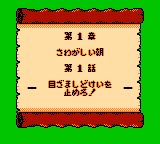 |
The intro scroll was shortened in the Japanese release, likely due to the smaller amount of text required.
Penguin
| International | Japan |
|---|---|
In the Japanese version, the penguin enemies carry and toss full beer mugs. In other versions, they are bowling balls, though the effects are still the same (which explains why Crazy Wario acts intoxicated until reaching water).
Revisional Differences
Save Data
A significant change with the Game Boy Color-enhanced releases is that a save file created when playing the game on the Game Boy Color cannot be resumed if the game is later played on a Game Boy/Super Game Boy, and vice-versa - the player must navigate a menu and delete all progress to play the game on the other system.
It is unclear why this restriction even exists in the first place -- hacking the game to remove the check for which system the game is running on (to allow the save to be run on any system) doesn't seem to cause any issues. A more detailed explanation can be found on the notes page.
Graphical Changes
| Game Boy | Game Boy Color |
|---|---|
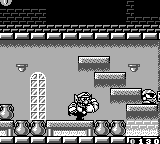 |
 |
Even if the game is played on a Game Boy or Super Game Boy, the Game Boy Color version loses a few graphical details. This is presumably due to palette issues--the window graphic in the above screenshot uses four colors, so if the arch at the top were kept, it would result in part of the surrounding wall turning blue.
Fish Enemy
In the original release, a unique fish enemy can be found in the "Turn off the giant faucet!" and "Escape from the Tea Cup!" levels. The fish is able to move both horizontally and vertically. When it sees Wario, it will try to catch him. Once the fish has caught Wario, it will pull him towards a wall and hold on to him until he escapes the fish's grip. It also seems to be connected to the boss of the "Escape from the ruins!" level, which has a similar attack and design and is named "Big Kamukamu" in Japanese sources, implying there should be a small version of it.
For whatever reason, this enemy was removed from the Game Boy Color version and replaced with the standard sawfish enemy. However, its graphics remain in the same object set as the room with the floating jug, and it even has a colorized version.
Rock Physics
In the level "Avoid the rocks!", the titular rocks exhibit slightly different behavior. In the original version, if Wario is holding a small rock while a large rock falls on top on him, the large rock will be destroyed while the small rock bounces away. In the Game Boy Color version, the small rock will not deflect the large rock, causing it to flatten Wario.
The Wario series
| |
|---|---|
| Wario Land | |
| Game Boy (Color) | Wario Land: Super Mario Land 3 • Wario Land II • Wario Land 3 |
| Game Boy Advance | Wario Land 4 |
| GameCube | Wario World |
| Nintendo DS | Wario: Master of Disguise |
| Wii | Wario Land: Shake It! |
| WarioWare Inc. | |
| Game Boy Advance | Mega Microgame$! (Demos) • Twisted! |
| GameCube | Mega Party Game$! |
| Nintendo DS | Touched! (Demo) • D.I.Y. |
| Nintendo DSi | Bird & Beans • Paper Airplane Chase (iQue Prototypes) |
| Wii | Smooth Moves • D.I.Y. Showcase |
| Wii U | Game & Wario |
| Nintendo 3DS | WarioWare Gold |
| Nintendo Switch | Get It Together! • Move It! |
| Miscellaneous | |
| NES | Wario's Woods |
| SNES | Mario & Wario • Wario's Woods |
| Game Boy (Color) | Wario Blast: Featuring Bomberman! |
| See Also | |
| Mario • Rhythm Heaven | |
- Pages missing developer references
- Games developed by Nintendo R&D1
- Games developed by TOSE
- Pages missing publisher references
- Games published by Nintendo
- Game Boy games
- Super Game Boy games
- Game Boy Color games
- Pages missing date references
- Games released in 1998
- Games released in October
- Games released on October 21
- Games released in March
- Games released on March 9
- Games released on March 26
- Games with unused areas
- Games with unused enemies
- Games with unused objects
- Games with unused graphics
- Games with regional differences
- Games with revisional differences
- Pages with a Data Crystal link
- To do
- Wario series
Cleanup > Pages missing date references
Cleanup > Pages missing developer references
Cleanup > Pages missing publisher references
Cleanup > To do
Games > Games by content > Games with regional differences
Games > Games by content > Games with revisional differences
Games > Games by content > Games with unused areas
Games > Games by content > Games with unused enemies
Games > Games by content > Games with unused graphics
Games > Games by content > Games with unused objects
Games > Games by content > Pages with a Data Crystal link
Games > Games by developer > Games developed by Nintendo > Games developed by Nintendo EPD > Games developed by Nintendo SPD > Games developed by Nintendo R&D1
Games > Games by developer > Games developed by TOSE
Games > Games by platform
Games > Games by platform
Games > Games by platform
Games > Games by platform > SNES games > Super Game Boy games
Games > Games by publisher > Games published by Nintendo
Games > Games by release date > Games released in 1998
Games > Games by release date > Games released in March
Games > Games by release date > Games released in March > Games released on March 26
Games > Games by release date > Games released in March > Games released on March 9
Games > Games by release date > Games released in October
Games > Games by release date > Games released in October > Games released on October 21
Games > Games by series > Wario series
The Cutting Room Floor > Unimportant Awards > Game Boy games
The Cutting Room Floor > Unimportant Awards > Game Boy games
The Cutting Room Floor > Unimportant Awards > Game Boy games > Game Boy Color games
